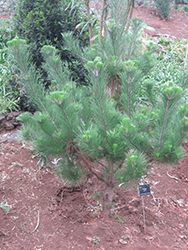It's all about ...
plants

Height: 80 feet
Spread: 50 feet
Sunlight:
![]()
Hardiness Zone: 8b
Other Names: Insignis Pine, Radiata Pine
Description:
A California native variety featuring a straight to contorted trunks and upward pointing branches with rounded tops; attractive foliage is deep yellow-green; cones form and remain closed until the heat of a forest fire; an impressive landscape accent
Ornamental Features
Monterey Pine is primarily valued in the landscape for its ornamental upright and spreading habit of growth. It has forest green foliage with hints of chartreuse. The large needles remain forest green throughout the winter. The brown fruits are held in cones in mid summer.
Landscape Attributes
Monterey Pine is an evergreen tree with a strong central leader and an upright spreading habit of growth. Its average texture blends into the landscape, but can be balanced by one or two finer or coarser trees or shrubs for an effective composition.
This is a relatively low maintenance tree. When pruning is necessary, it is recommended to only trim back the new growth of the current season, other than to remove any dieback. It has no significant negative characteristics.
Monterey Pine is recommended for the following landscape applications;
- Accent
- Shade
- Naturalizing And Woodland Gardens
Planting & Growing
Monterey Pine will grow to be about 80 feet tall at maturity, with a spread of 50 feet. It has a low canopy with a typical clearance of 4 feet from the ground, and should not be planted underneath power lines. It grows at a slow rate, and under ideal conditions can be expected to live for 70 years or more.
This tree should only be grown in full sunlight. It does best in average to evenly moist conditions, but will not tolerate standing water. It is not particular as to soil pH, but grows best in poor soils, and is able to handle environmental salt. It is highly tolerant of urban pollution and will even thrive in inner city environments. This species is native to parts of North America.
This plant is not reliably hardy in our region, and certain restrictions may apply; contact the store for more information.
